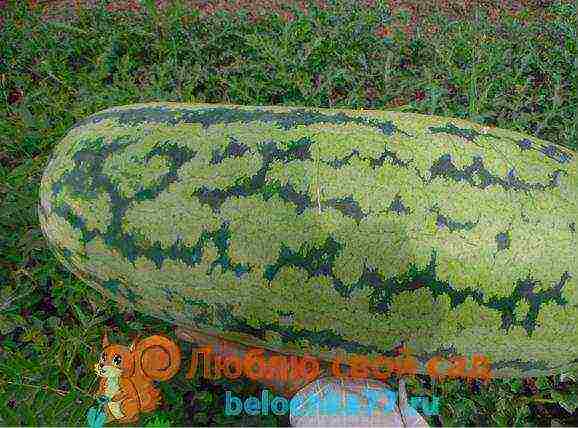Content
- 1 The best varieties of watermelons
- 1.1 Early varieties of watermelons
- 1.2 Varieties for central Russia
- 1.3 Varieties of watermelons for the Moscow region, for open ground
- 1.4 For the Urals and Siberia - what varieties of watermelons are grown in Siberia
- 1.5 Watermelon varieties with yellow flesh
- 1.6 Yellow Watermelon - Gift of the Sun
- 1.7 Densuke is a black variety of watermelon
- 2 The most productive varieties of watermelons
- 3 Optimal conditions for growing watermelons
- 4 How to grow seedlings correctly
- 5 Early ripening varieties of watermelons
- 6 Varieties of early ripening watermelons for the middle strip
- 7 Early ripening varieties of watermelons for the Moscow region
- 8 Watermelon varieties for cultivation in Siberia
- 9 Heading "Question-answer"
Good day to all readers!
The work of breeders now gives us the opportunity to grow in central Russia and more northern regions not only the usual fruits and vegetables, but also such a heat-loving culture as watermelon. Today, minke whales are grown even in northern latitudes. Ripe fruits cannot boast of huge size, but they have juicy pulp and sweet taste.
Where to start if you decide to grow watermelons on your plot? The success of the event directly depends on the correctly selected variety. And of course, you should study agricultural agricultural technology if you have not had such experience. Today are the heroes of the day
The best varieties of watermelons
Early varieties of watermelons
It makes no sense to explain the popularity of early varieties of watermelons. And so it is clear that everyone would like to open the season for the use of this berry as early as possible. Experts have tried and made us happy with the early varieties. Let's give a brief description of the best of them.
Turbo F1
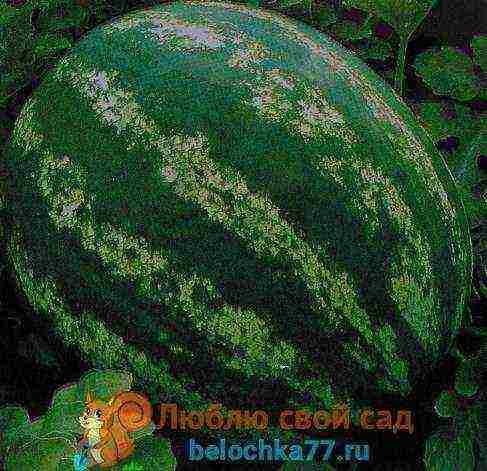
Refers to ultra-early hybrids. Ripening takes place in just 55 days. The plant is characterized as a powerful hybrid with strong roots. With drip irrigation, it forms 4-5 ovaries on each lash. Fruits are oval in shape, dark green in color with light stripes, weighing from 9 to 15 kg. The pulp tastes very good.
Ataman F1

A hybrid variety that ripens from 70 to 85 days. The plant has a strong root system and developed leaves. Fruits are elliptical, green in color, the stripes are poorly expressed. The pulp is bright red, has a rich sweet taste. The variety is high-yielding, the fruits have a long shelf life.
Farao F1
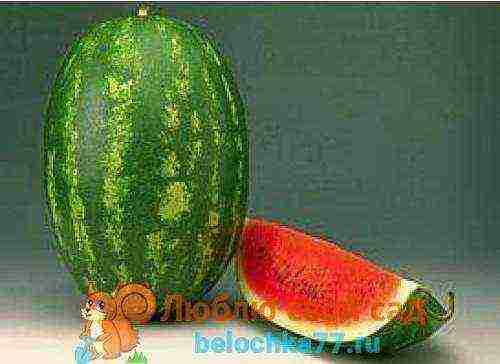
Ripens as much as the previous hybrid. The berries are elongated. Their color is dark green with light green stripes. The skin is thin, shiny in appearance. The scarlet pulp contains maroon bones. Suitable for growing on any soil. The variety is resistant to diseases. The weight of 1 fruit reaches a maximum of 6 kg.
Karistan F1
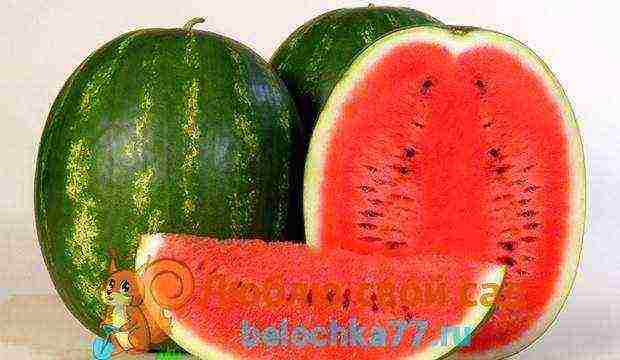
Another early variety suitable for growing in most climatic zones of Russia. The plant is strong, with a powerful root system. The berry is oval in shape, the crust is shiny, smooth, the color can be either dark green or light. The standard weight is 3-5 kg, some specimens can reach 12 kg. The pulp is dense, juicy, tasty.
Producer

Ripening of berries occurs on days 65-70. Suitable for greenhouses and open ground. The fruits are round, with alternating dark and light green stripes. The crust is thin, the pulp is granular in structure, sugar. Average weight of fruits is 7-9 kg. The variety is high yielding and disease resistant.
Red Star F1
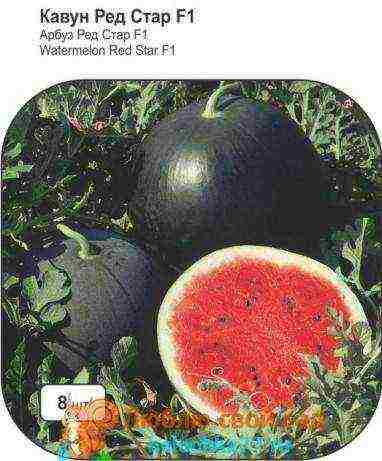
The culture is intended for planting in open and closed ground. This is an early ripening hybrid with a growing season of 60-65 days. The skin is dark green in color. The fruits grow in a round shape. The variety does not require special care and is disease resistant.The pulp is dark red, sweet. In the middle lane in early spring, a film shelter is used.
Early varieties are ideal for growing in the Moscow region, Siberia and the Urals, as they have a good growth rate, disease resistance and high yields.
Varieties for central Russia
To get a full harvest of watermelons in central Russia, you need to choose early ripening varieties, the emphasis is on this. You should not chase the huge size, because of the climatic conditions, you still will not get large fruits. If you grow watermelons for yourself, you also do not care about transportability or the color of the berries.
Pay attention to the following representatives of melons and gourds:
Romanza F1
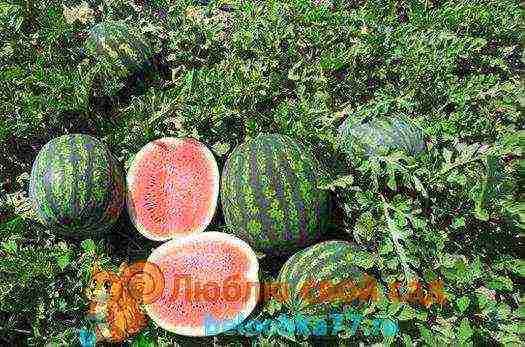 Romanza F1
Romanza F1
The mid-early hybrid ripens in 76 days from the moment of sowing. Fruits are round in shape, average weight 9-12 kg. The pulp is pink-red, sugary, with very small seeds. The variety sets fruit perfectly and gives a high yield. During the season, watermelons can be obtained from one plant three times.
Bomb F1

High-yielding mid-early hybrid. Fruits are oval, large, with an average weight of 11-13 kg. With a rare planting, the berries grow even larger. The skin is green with dark stripes. The pulp is delicious, sweet. Does not require frequent watering. The fruits have a long shelf life.
Icarus
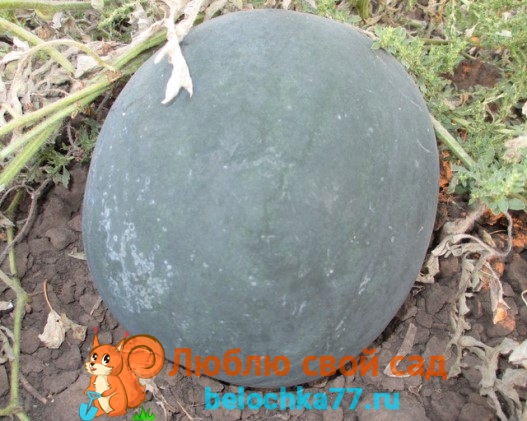
The variety is considered medium late. From sowing to fruiting, 90-110 days pass. The shape of the fruit is round-elliptical. Their weight varies from 6 to 16 kg. The rind is dense, of medium thickness, dark green in color. The stripes are almost invisible. The pulp is raspberry in color, sugar, with a small amount of seeds. A feature of the variety can be considered a long storage period for the crop.
Astrakhan watermelon

Grown throughout Russia, it is considered an unpretentious and fruitful medium early variety. The fruits have a long shelf life and good transportability. The culture is very resistant to disease. The shape of the fruit is round or oblong. The main background of the skin is dark green with light stripes. The pulp is red, juicy, aromatic. Fruit weight from 8 to 10 kg.
Melania F1
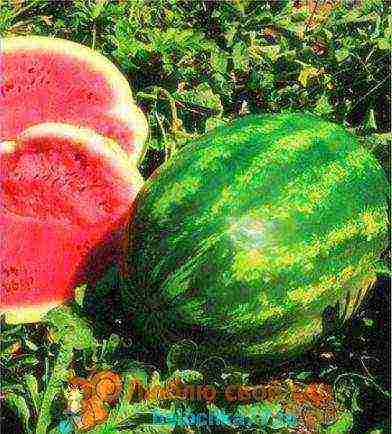
Refers to early hybrids, ripening 80 days after germination. The variety is strong, resistant to diseases and changing weather conditions. Fruits are oval in shape, weighing 8-10 kg or more. In order for the crop to ripen in the middle lane, it is recommended to grow under a non-woven covering material. For seedlings, seeds are sown in pots towards the end of April. The hybrid has excellent taste.
Vizier F1

Medium ripening hybrid. The variety gives a bountiful harvest, easily tolerates transportation. Fruits are elongated. From the moment of sowing to harvesting, 68-72 days pass. It has strong roots and a powerful leaf apparatus. Fruits are uniform in size, with an average weight of 10-14 kg. The rind surface is bright green with uniform dark stripes. The rind is thick and shiny. The pulp is firm, dark red, sugary.
Crimson sweet
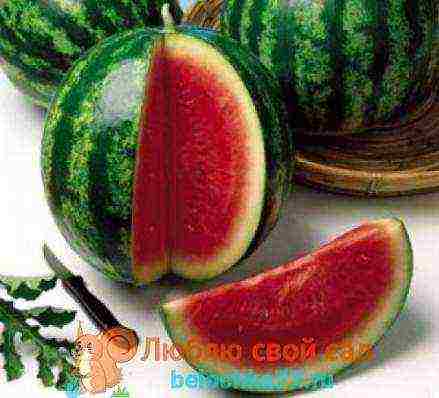
An ideal sugar variety for growing in central Russia, it has a super early ripening period. From the moment of sowing to harvesting, 70-80 days pass. Under ideal growing conditions, the weight of the fruit can vary from 5 to 12 kg. The shape of the watermelon is slightly oblong, dark green in color. Lighter stripes run across the main background. The pulp changes color during ripening from pink to red, sweet in taste. The variety is resistant to diseases, can grow on arid soils.
Kimara
This variety is an improved variety of Crimson Sweet. Productive, high-yielding plant. It has large elliptical fruits weighing 13-15 kg. Chimera belongs to the mid-early varieties, from the moment of germination to ripening it takes 75-80 days.
The color of the peel is light green with dark green stripes. The pulp is sweet, crispy, deep red. In terms of sugar content, minke whale surpasses Crimson Sweet.
Tamerlane F1
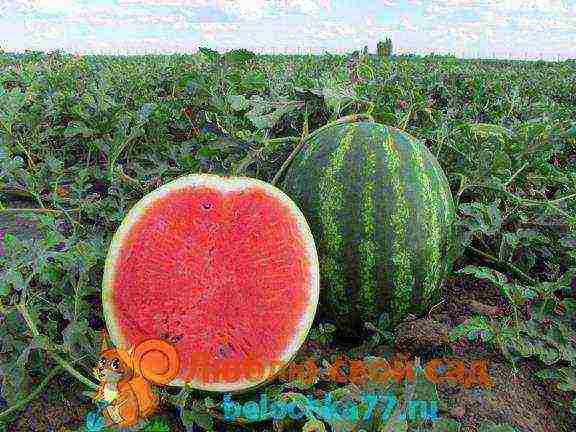
High-yielding medium late variety (Crimson suite type).It is successfully grown in garden beds, but the plants require shelter. The variety is adapted for cultivation in various climatic zones. Ripening period is 95 days from the moment of emergence. The plant grows with a powerful stem. The fruits are oval, their color alternates between light and dark green stripes. The average weight of watermelons is 12-14 kg. The pulp is red, firm, and has no voids. The culture loves drip irrigation.
The main focus is on how many days elapse from the start of fruit set to ripening. This information is usually found on the packaging. Mid-late varieties of watermelons are also grown in the middle lane, but in a greenhouse, using the seedling method.
Varieties of watermelons for the Moscow region, for open ground
If your site does not have a greenhouse, then when planting watermelons, you should pay attention to varieties that can actually be grown in the open field. Since the summer in the Moscow region is not very hot and rather short, it is advisable to select early early ripening varieties and grow them using the seedling method. Consider the following candidates:
Suga Baby
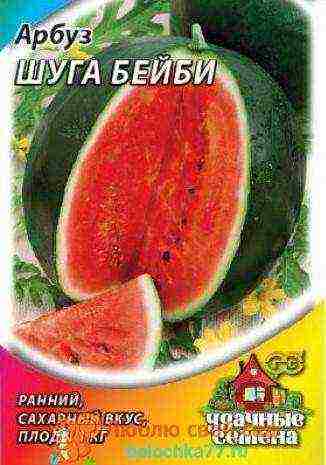
Sugar baby matures in 65-70 days. The fruit is perfectly round and dark green in color. The peel is thin. The pulp has a grainy texture, sugar in taste. Fruits are medium-sized, weighing from 1 to 6 kg. The variety is adapted to different climatic conditions. It can be grown outdoors and under film cover.
Maristo F1
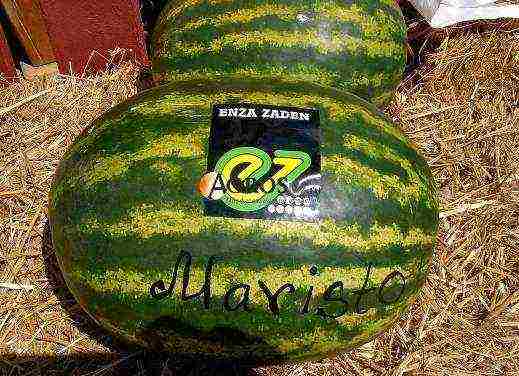
New hybrid variety with early maturity. The growing season lasts 58-60 days. The variety is resistant to fusarium and anthracnose. The fruits weigh 9-11 kg and are dark green in color with light stripes. The pulp is dense, rich in color, sugar and aromatic. The crop is subject to long-term storage and tolerates transportation well. Maturation is amicable.
Erken F1
Ultra-early, productive, reliable hybrid. The variety was bred quite recently. The best yield results are obtained with the seedling method of planting using thermoses. It is resistant to diseases, does not require special care. Bears fruit stably in various weather conditions. Fruits are round, weighing from 8 to 10 kg. Dark stripes cover the light green background. The flesh is sweet and crunchy, dark red in color.
Baraka F1
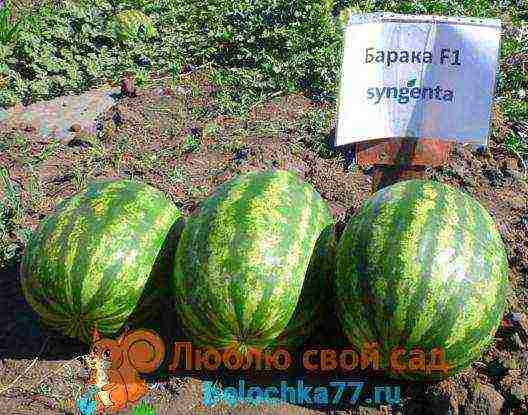
The hybrid was bred for growing in the open field. With the seedling method of planting, ripening occurs in 2 months or a little longer, with direct sowing 72-77 days. The average fruit weight is 11-13 kg. The hybrid has a dark red flesh with a high sugar content and small seeds. Fruits are oval in shape, perfectly stored.
Anniversary
The hybrid is intended for growing in a greenhouse, but can also grow outdoors. The variety is considered to be medium ripe; it takes about 95 days to ripen. When planted in open ground, they are grown in seedlings. Can be used in both southern and northern latitudes. Fruits are oval in shape, weighing up to 10 kg. The color alternates between light and dark green stripes. The pulp is tender, sugary, rich scarlet color.
Be sure to use a film shelter when growing watermelons in the Moscow region. This is especially true in spring, when the nights are cold and there may be unexpected frosts.
For the Urals and Siberia - what varieties of watermelons are grown in Siberia
The wonders of breeding today make it possible to grow watermelons even in areas of risky farming - in Siberia and the Urals. When developing varieties for these regions, the need for a culture to endure difficult weather conditions, withstand low temperatures, and ripen in a short summer period was taken into account. The following varieties are most suitable for cold regions:
Chill
This name is due to the qualities of this berry. The variety easily tolerates low temperatures, up to small frosts. The bushes are very powerful, the main shoot can grow up to 5 m in length.
Fruits are spherical, slightly elongated. Average weight ranges from 5 to 7 kg. The main color of the peel is greenish; a weak mesh is visible on it. There are dark stripes on the main background.
The pulp is deep red, sweet, contains large brown seeds.
The variety is unpretentious in care and storage. From the moment of germination to harvest, 85-97 days pass.
Siberian lights

An early ripe variety with medium-sized fruits weighing 2.5-5 kg. It takes 80 days from germination to ripening. Bred specifically for cold areas. It tolerates drought and low temperatures well. Can be grown outdoors and indoors.
The variety is high yielding and resistant to fusarium. Watermelons are round in shape, dark green in color. The pulp is juicy, tasty, there are few seeds.
In Siberia and the Urals, varieties intended for central Russia can also be planted. In this case, watermelons are necessarily planted using a seedling method and subsequently grown in a greenhouse. Otherwise, the crop will either not have time to ripen, or will not meet your expectations with its size and taste.
Watermelon varieties with yellow flesh
Watermelon varieties with yellow flesh are in no way inferior to traditional varieties in taste, but at the same time they look very original. If you want to surprise guests not only by the fact that you have grown a watermelon with your own hands, but also by its unusual appearance, pay attention to the varieties of crops with yellow pulp that are suitable for your region.
Lunar
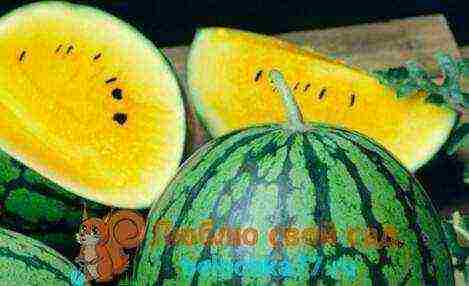
An early ripe hybrid bred in Astrakhan. The name of the variety speaks for itself, since the half slices of watermelon are very reminiscent of the moon in their appearance. The size of the fruits is not very large, the average weight is 3-4 kg. From the outside, the watermelon is similar to its fellows, which have red flesh, and its smell resembles the aroma of the Astrakhan watermelon.
The pulp is juicy and tender, contains a minimum amount of seeds. The taste is sweet, with a light lemon note. The variety belongs to the early ripening species, the fruits ripen for about 90 days. Seeds are planted on seedlings at the end of April, and after 30 days the plants are planted in open ground.
Surprise
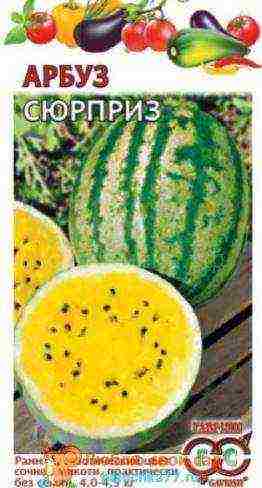
It grows well in central Russia under a film cover, an early-maturing variety. Refers to hybrids with yellow flesh. The fruits are oval, light green in color with dark stripes. The pulp has almost no seeds, juicy, sweetish. The fruit gains a mass of 4-4.5 kg even with a small number of sunny days. It is grown in seedlings in the open field. The harvested crop is perfectly preserved for 2-3 months.
Seedless yellow F1
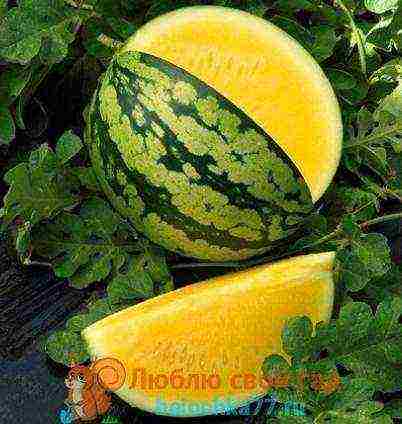
The name of the variety speaks for itself. It is a hybrid novelty with medium-sized rounded fruits. The hybrid belongs to the early maturing varieties, it is resistant to diseases and unpretentious in care. The crust of the fruit is thin. The pulp is juicy and tender, it tastes like a mango. Seeds are almost absent. Watermelon is consumed fresh, used for making candied fruits and desserts.
Yellow Watermelon - Gift of the Sun
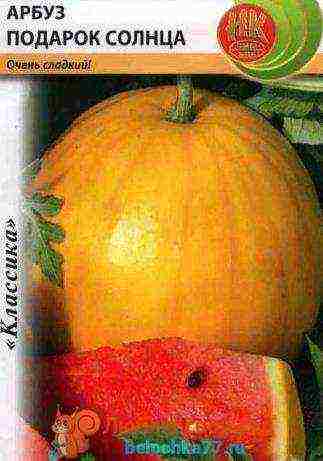
Gift of the Sun is an ultra-early ripening variety with a ripening time of about 2 months. Ripe fruits have a slightly elongated shape and weigh an average of about 3.5-4 kg. Particularly large specimens can reach 6-7 kg. A variety with a delicate, sweet taste, and a golden yellow skin. This culture is frost-resistant; gardeners grow it in the cold climatic conditions of Siberia.
Densuke is a black variety of watermelon
Densuke
It is interesting! A rare representative of this culture is the Densuke black watermelon. It is considered one of the exclusive varieties. The rind has a glossy black color. The fruit is round in shape. The flesh of this berry is bright red, sweet in taste. The variety was bred and grown in Japan and is considered the most expensive in the world. The average weight of Densuke is 5-7 kg. They sell exotic berries at local auctions and online.
The most productive varieties of watermelons
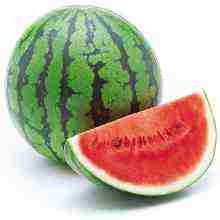 Hello dear friends!
Hello dear friends!
Buying a watermelon in the market or in a store, no one can guarantee that it is tasty, juicy, ripe, and most importantly safe. Growing a watermelon in your garden, with care and the right choice of seeds, you can get sweet, healthy and juicy watermelons that both adults and children can eat without fear.
Let's talk about which variety of watermelon is better and more productive?
All varieties of watermelon love plenty of sun, moisture and heat. For growing these large berries, sandy loam and sandy soil is considered the best.
It is better to plant watermelons in the place where onions and cabbage are grown.
The best yielding varieties of watermelons
- The Sugar Baby variety is an early fruitful variety that ripens in 2.5 months. This variety is suitable for canning and salting for the winter. Fruits reach 8 kilograms, round, dark green in color. The pulp is red, grainy, tasty, sweet, juicy with large seeds.
- Delicacy, this is an early variety, with fruits up to 10 kilograms. Does not get sick, gives a bountiful harvest. The pulp is rich raspberry, sweet, grainy.
- Twinkle, one of the most common early high-yielding watermelons. 2.5 months pass from planting to harvest. The pulp is red, tender. Round fruits weigh up to 2.5 kilograms, the skin has a dark green color, with faint stripes. There are many seeds and they are small.
- Crimson sweet is an early variety. It matures in 2.5 months. Fruits are round and large (up to 7 kilograms), their color is green. The pulp is tender, tasty, red in color. The seeds are large. Not afraid of diseases, perfectly transported.
- The Chill variety comes from mid-season. Ripens in 3 months. There are not many seeds. The fruits are large (up to 10 kilograms), green in color with light specks, round. They are well transported and stored. The pulp is red-pink, juicy and tasty.
- Charleston Gray is a medium-ripening variety. It should take 3 months from planting to harvest. The fruits are oval, the skin is light green with streaks, the size reaches 15 kilograms or more. The pulp is red, sweet, aromatic and tasty. There are few seeds. Well transported and stored.
- A gift from the sun, this is an early variety that ripens in a little over two months. The pulp is juicy, red, grainy. The fruits have a golden yellow color (similar to pumpkin), weigh about 6 kilograms, round.
- Lunny, this is an early variety. Fruits are oval, light green in color, dark, narrow stripes. The pulp is yellow, sweet. Fruit size is 4 kilograms or more. Well transported.
- Hybrid Prince Albert, early, round, small fruits, have a golden color. The pulp is red, sweet, few seeds.
- Hybrid Prince Hamlet, early, small fruits, up to two kilograms. The pulp is bright yellow, sweet, without seeds.
It is impossible to say unequivocally which variety of watermelon is better and more productive. After all, all these proven varieties have established themselves over time. And with good watering, care and favorable weather, they will give an excellent harvest, which can be treated to households and guests. And new varieties, hybrids, will surprise you with their taste and appearance. See you!
Watermelon not only benefits the human body, but also quenches thirst in the summer heat, it is used to make various dishes and drinks. There are an incredible variety of varieties of this berry, when choosing, sometimes your eyes just run up. The best varieties of watermelons, their features and benefits will be described in the article.
The best yielding varieties of watermelons
The first thing a gardener counts on when planting a crop is a large, high-quality harvest. The most productive varieties of watermelon are listed below.
- "Sugar baby" - yield - 100 t / ha with proper care. The mass of one round berry is 3-5 kg. The peel is green, with subtle dark, thin stripes. The pulp is sweet, red in color. Resistant to anthracosis, powdery mildew.
- Charleston Gray yields up to 100 t / ha. The variety has a bright pink color of the flesh, the rind is light green, without stripes. The shape of the fruit is longitudinal, oval. Berries up to 14 kg, sweet, juicy, can be stored for a long time.
- Crimson Sweet - 60-70 tons / ha. Fruit weight - 8-12 kg. The color of the peel is dark green, the stripes are light. The flesh of the watermelon is deep red, crispy and sweet. Resistant to long haulage, drought, frost, but it is recommended to spray against diseases.

The best fruit varieties of watermelons
- "Delicacy F1" gives up to 40 tons of finished product per hectare. The rind is dense, green with dark stripes.The color of the pulp is crimson. Fruit weight 5-10 kg. The shape is round, disease resistant. Used for pickling and fresh consumption.
- "Ogonyok" Is one of the most popular varieties of watermelon. Refers to productive species - 35 t / ha. The average fruit weight is 2.5-3 kg. The pulp is red, juicy. The peel is black-green. Resistant to frost, anthracnose, fusarium.
- "Chill" has a high yield - 30-35 tons / ha. Stored up to 5 months after harvest, transportable. Fusarium resistant. The color of the peel is dark green with light green, uniform spots. The pulp is deep red, sweet. The fruit weighs in the range of 5-7 kg.
How to choose a variety according to the ripening period?
Depending on the ripening period of watermelons, they can be grown in different areas. For the southern ones, any varieties are suitable, and in the northern ones only early crops bear fruit.
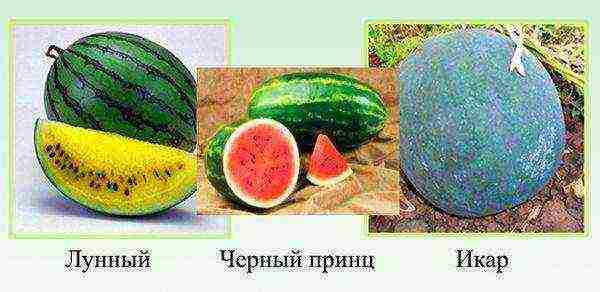
Watermelon varieties by ripening period
- Early varieties of watermelons ripen very quickly in 60-80 days: "Sugar Baby", "Lunny", "Ogonyok", "Zenith", "Prince Hamlet F1", "Regus F1", "Sagi F1", "Sanday Special", Winner 395, F1 Yellow Buttercup, Charleston Gray.
- Mid-season varieties ripen in 80-90 days on average. These include: "Black Prince", "Astrakhan", "Volzhanin", "Bykovsky - 22", "Imbar F1", "Delikates F1", "Crimson Sweet".
- Late varieties of watermelons ripen in 90 days or more. These include: "Ikar", "Chill", "Red King", "Favorite farm of Pyatigorsk 286", "Melitopolsky 60".
What are the sweetest varieties of watermelon?
The sweetness of a watermelon is one of the most important criteria when choosing a berry. Unsweetened fruits are usually bought for canning, but for fresh consumption it is important that the watermelon is tasty and sweet. So what are the sweetest varieties of watermelon?
- "Melitopolsky 60" - 12% sugar in the fruit. The variety can be stored for a long time - up to 3.5 months, under proper conditions it is transportable. Fruits up to 10 kg, very tasty with pink pulp.
- "Winner 395" contains 9-11% sugar. The variety is very sweet, it is recommended for fresh consumption. The fruits are slightly elongated, but not oval. The pulp is red. The berry weight is 4-6 kg on average.
- "Bykovsky - 22" - sugar content 8.3-9.5%. The berry is spherical, smooth, weighing 10-14 kg. The peel is dense (1-1.5 cm), light green with dark green narrow, almost even stripes. The pulp is bright pink, juicy, grainy. Productivity - 25-35 t / ha. Resistant to drought, powdery mildew and fusarium.
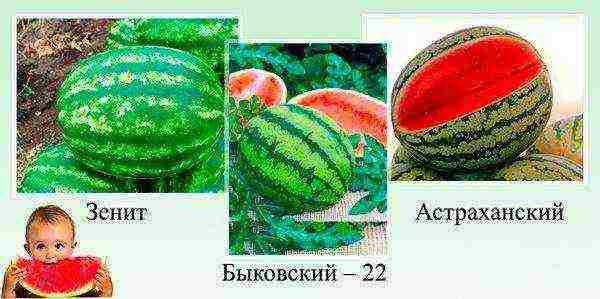
The sweetest varieties of watermelons
- "Astrakhansky" contains sugar - 7-9%. Fruits, as a rule, are oval, with weak segmentation, weighing 3-6 kg. Large fruits often have voids inside. The bark is thick up to 2 cm - high transportability. The pulp is bright pink, granular, very juicy (dry matter 8-11%). With proper care, the yield can reach 120 t / ha. It is important to spray the plant on time from pests and diseases!
- "Favorite farm Pyatigorsk 286" contains 7.9-8.8% sugar. It is not transportable, as it quickly deteriorates - it is used fresh. The peel is not thick, light green with narrow, dark green stripes weighing 3-9 kg. The pulp is pink.
- "Zenith" contains 8.2% sugar. Rounded fruits weighing 2.5-6.8 kg. The peel is up to 1.2 cm thick. The pulp is purple, juicy, grainy. Dry matter is only 9.5%. Yields vary greatly from region to region. With normal cultivation in mid-latitudes, 1.5-10 tons / ha can be harvested, in the North Caucasian region up to 35 tons per hectare are harvested on dry land. The fruits are stored for less than a month, therefore, it is not recommended to transport them over long distances. Drought tolerant.
- Volzhanin is considered one of the sweetest varieties of watermelon that are sold everywhere. The sugar content is 7.2%. Fruits are light green with dark stripes, the flesh is red, granular, with seeds. Fruit weight up to 16 kg. The growing season is 80-85 days. In the northern regions it can be up to 100 days. Up to 30 tons of watermelons can be harvested per hectare with good care. Drought tolerant.Used for fresh consumption.
Unusual varieties of watermelons 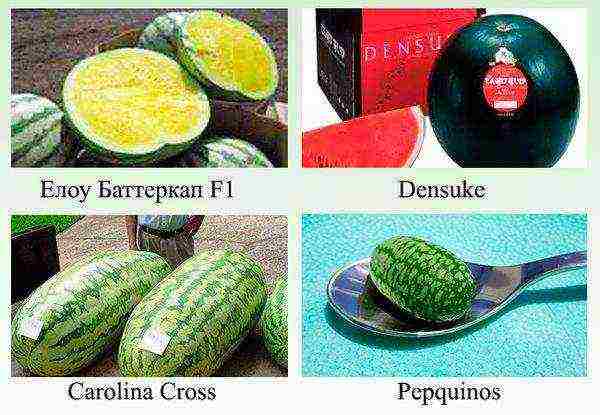
Unusual varieties of watermelons
All over the world, large and miniature watermelons like Carolina Cross and Pepquinos are grown, and there are record holders in terms of ripening and sweetness. But what other unusual varieties of watermelons were created by nature, breeders and are successfully grown in different countries?
- Seedless watermelons are popular all over the world. For some consumers, picking seeds is a very troublesome business, and seedless watermelons allow you not to waste time, and enjoy a lot of sweet berries. There are many similar varieties. Yellow varieties of watermelons: "Lunny", "Elow Buttercup F1", "Imbar F1" or red: "Red King", "Sagi F1", "Sanday Special", "Regus F1". "Prince Hamlet F1" is low-seeded and often includes seedless varieties.
- "Densuke" is grown on the island of Haikido (Japan). The watermelon has a black rind and bright, red flesh. Very tasty, but its peculiarity is rare and a huge price (up to $ 60,000), which gourmets are ready to pay for an unusual berry.
- Recently, the popularity of unusual shaped watermelons has increased. In Japan, production for the cultivation of square watermelons has been established. In typical household farms, gardeners try to make interesting watermelons of an unusual shape: a heart, a cone, a pyramid, a pear, a square, a rectangle, and the like. Of course, the price for such fruits is much higher than for the usual round or oval berries.
Breeders have studied in detail the nature of heat-loving crops and developed a technology for growing them in regions with short summers. So cold-hardy and early ripening watermelons with a short growing season were bred - early and mid-early. Since then, everyone can grow this culture in central Russia, the Moscow region and even in Siberia. We will tell in the article in detail about these varieties, their cultivation features.
Optimal conditions for growing watermelons
Watermelon is a warm and light-loving culture. Seeds are able to germinate at a temperature of at least +17 degrees, but the optimum temperature is + 25-30 degrees during the day and +18 degrees at night. Watermelon is drought-resistant, reacts poorly to high air humidity, which can provoke the development of fungal diseases.
The most acceptable air humidity is 60-70%. Thus, watermelon is picky about the temperature of the soil and air, the duration of the growing season. These conditions are rather difficult to implement in central Russia, in Siberia. Therefore, the success of growing watermelons here depends on the correct choice of varieties and the provision of the necessary agricultural technology. Read also the article: → "Technology of growing watermelons in Siberia."
How to grow seedlings correctly
Early ripening variety of watermelon in the garden
In the middle lane, Moscow region, Siberia, a watermelon can be grown exclusively through seedlings. And it must be of high quality, since the harvest depends on it. The growing period for seedlings is only 30-35 days. This must be done in pots so that when planting in open ground, it does not damage the root system. It is desirable that the pots have a diameter of 10 centimeters - in this case, two plants are grown in them at once.
Before sowing, the seeds are soaked or germinated - this will shorten the germination period. To get good friendly shoots, seeds need to provide a temperature of + 27-30 degrees during the day and + 18-20 degrees at night. Seeds for seedlings should be sown around mid-April. The seedlings should grow in the sunniest part of the apartment - for example, on a windowsill on the south side.
Tip # 1. The quality of seedlings will increase if they are grown on a glazed and insulated loggia. At the same time, it is imperative to monitor the temperature.
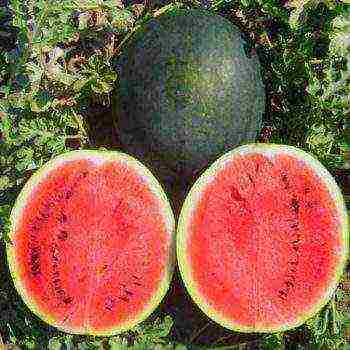
Early ripening popular watermelon variety Sugar baby
During the cultivation of seedlings, 2 additional fertilizing with complex mineral fertilizers are carried out. The arrangement of plants is important: they should not touch the leaves, so from time to time the pots are pushed apart.Seedlings ready for planting should have 3-5 true leaves. A week before planting, the seedlings need to be hardened: the daytime temperature drops to 15-17 degrees, the nighttime temperature drops to 12-15 degrees. Plants are also heavily ventilated.
For regions with cool and short summers, early ripening varieties of watermelons are most suitable. They mature in just 60-80 days. Usually, these varieties of watermelons are small - they weigh no more than 3 kilograms - but they are very sweet and tasty. They have a thin peel, so they cannot be stored for a long time, and they are vulnerable to mechanical damage.
Early ripening varieties of watermelons
The most popular varieties are presented in the table with a description of the characteristics and ripening periods:
| Variety name | Characteristic |
| Prince Albert F1 | Early ripening fruitful variety. Ripening period 75-80 days. Fruits with thin skin, yellow, small, with a delicious taste: the red pulp is very juicy, sweet. The mass of one watermelon is 2-3 kg. Storage is short. Best consumed fresh. |
| Prince Hamlet F1 | The variety is early maturing. Ripens in 70-80 days. Fruits are medium in size, round, striped, with thin skin. The seedless pulp is very juicy and sweet, bright yellow. The weight of one watermelon is 1-2 kg. The variety can be grown in regions with unfavorable climatic conditions. It is immune to disease. |
| Sugar baby (Suga baby) | Early ripening popular variety. Ripening period 65-80 days. It is unpretentious in cultivation, resistant to difficult climates and various diseases. Dark green fruits have a black tint. The sizes are average. The shape is round. The dark red pulp is very tender, sweet, sugar, juicy. Watermelon weight 2-5 kg. The variety has excellent commercial qualities, excellent immunity to diseases. Cold resistant. |
| SRD-2 (Very early Dyutina-2) | The variety is very early ripening: ripening period is 55-60 days. The fruits are elongated and rounded. Their average weight is 5-9 kg. The surface is slightly ribbed, smooth with dark green narrow prickly stripes on a light green background. Hard, thick skin. The red pulp is sweet, juicy. The variety is resistant to melon aphids, powdery mildew, anthracnose. |
| Skorik | The ripening period of the variety is about 2 months. The fruits are large, striped, with black seeds. The shape is spherical. The rind is smooth. The pulp is dense, very tasty, juicy, aromatic, with fibers. Weight 1-4 kg. High-yielding variety. |
| Reddish | The growing season is 65-80 days. The fruits are round. The peel is white with narrow green longitudinal stripes. Their weight is about 8 kg. The average yield is 50 t / ha. Raspberry pulp is coarse-grained, tasty, with small seeds. The variety is resistant to anthracnose, fusarium leaf wilt. |
| Producer | Early ripening variety - ripening period 62-85 days. Fruit weight is about 5 kg. Their shape is spherical. The pulp is red with brown blotches, with small seeds. The variety is resistant to disease. Productivity is 20-50 t / ha. |
Varieties of early ripening watermelons for the middle strip
There are many early ripening varieties that have their own characteristics and require a different approach to cultivation.
It is very important to find the right variety here. For the cultivation of watermelons in central Russia, extremely early ripening varieties are suitable. You should not pay much attention to the size of the fruits, here they still will not grow large due to climatic conditions. Transportability and fruit color are also not important when choosing a variety. In the description of the variety, attention should be paid to the number of days from fruit setting to ripening.
It is advisable to give preference to varieties that have time to ripen, taking into account the characteristics of the climate of the middle zone and have excellent taste. You can safely choose the following varieties: the above-described Sugar Baby (Suga baby), as well as the Gift to the North F1, Krimstar F1, Pink Champagne F1, Charleston near Moscow, Cinderella. And further:
| Variety name | Characteristic |
| Twinkle | Early variety, very popular. High in sugar. High-yielding.Dark green, almost black fruits are small - weight up to 2.5 kg, juicy, very sweet. The shape is spherical. The variety is winter-hardy, resistant to diseases. |
| Lady F1 | Ultra early hybrid. Vegetation lasts 2 months. Fruits are oblong, striped. With proper care, they can grow up to 12-15 kg. Juicy, sugary. They are immune to fusarium. They tolerate a lack of moisture in the soil. The fruits are not prone to cracking. |
| Crimson Sweet F1 | Medium early variety, bred by American breeders. All of its characteristics are excellent. The average size of the fruit reaches 8-11 kg. Striped, rounded, sometimes slightly elongated. Delicious, sweet, bright red inside. The variety is resistant to fusarium and lack of moisture. |
| Romanza F1 | Hybrid, medium early, of Dutch selection. It is very popular with gardeners as it is very sweet. Small fruits weigh up to 7.5 kg. They have a rounded shape. Striped. They have excellent keeping quality, which is not typical for early varieties. |
| Peasant | In regions with cold climates, this variety is used very often. The bark of the fruit is thick and strong. Therefore, the variety is cold-resistant. Transportable. The fruits are elongated. Sweet, juicy. |
Early ripening varieties of watermelons for the Moscow region
The key to a good harvest is the right choice of watermelon seeds. If the ripening period indicated on the package exceeds 85 days, then these seeds are not suitable for growing in the Moscow region, since the summer here is quite short, and watermelons are extremely demanding for light and heat. Read also the article: → "Features of growing watermelons in the Moscow region." The following varieties and hybrids of watermelons are suitable for cultivation in this region:
| Variety name | Characteristic |
| Seedless yellow F1 | The hybrid is considered a novelty among seedless varieties. The fruit has a round shape, medium size, thin rind, juicy flesh with a touch of mango flavor. This early maturing hybrid is resistant to various diseases. It is consumed fresh, watermelon honey, candied fruits, and various desserts are prepared from it. |
| Moon and Stars F1 | An early ripe hybrid. Also new. Has an original appearance: round like the moon with distinct specks on a dark surface. The pulp is very tasty and has a honey color and taste. Almost seedless. |
| A gift to the north F1 | Super-early hybrid with a ripening period of about 75 days. Fruit weight reaches 10 kg. High-yielding hybrid. Drought and disease resistant. It has a juicy, crispy pulp, very sweet. Transportable. |
| Gift of the Sun | This variety has a golden yellow skin. Ripening period 68-73 days. Inside it is bright red, juicy, delicately grainy. |
| Charleston near Moscow | One of the earliest hybrids. The time from sowing to harvesting is 80 days. The fruits are oval, large. The mass of one is on average 10 kg. They have a dark green color, smooth shiny bark. The inside is bright red, dense, sweet, delicious. |
Watermelon varieties for growing in Siberia
For colder climates, it is better to choose more resistant varieties.
The key to successful cultivation of watermelons in Siberia is:
- the right choice of varieties;
- competent agricultural technology;
- proper weather conditions.
The last factor is the most difficult to accomplish. Therefore, it is necessary to independently create the appropriate conditions: to grow seedlings with artificial supplementary lighting in a greenhouse or partially under a film. By the way, there is enough sun in Siberia: scientists have calculated the total amount of solar heat in Omsk and Crimea. So in Siberian Omsk there were more sunny days than in the south, where it rains more often, fogs occur. Although the weather in Siberia is also unpredictable, so you need to be prepared for its whims.
In the northern regions of Russia, there are many people who want to grow watermelons on their plots. For them, breeders have developed hybrid varieties of this berry - they are perfectly adapted for ripening in Siberia. Read also the article: → "Crimson Sweet" or "Raspberry Sugar" - early ripening watermelon ". In addition to the above-described varieties of Ogonyok and Crimson Sweet, these are:
| Variety name | Characteristic |
| Ultra early | Early ripening variety. The fruits are not large. Weight 2-4 kg. Inside is bright scarlet. The taste is very sweet. For germination, seeds are planted in early May. |
| Siberian | The variety is specially bred for Siberia. Unpretentious care. Resistant to temperature changes. Refers to early ripening varieties. Fruits weigh up to 5 kg. The inside is very sweet and juicy. |
| Crimson Wonder | Medium early grade. It grows very well in Siberia. Ripens in 85 days. Fruit weight reaches 10 kg. The skin is pale green with dark stripes. Inside, the fruit is red, delicate in taste, aromatic. Disease resistant and easy to transport. |
| Madera F1 | It is considered one of the best early maturing hybrids. Resistant to disease. Large fruits weigh 6-8 kg, round in shape, with light green stripes. The pulp is bright red, crispy, juicy. Fruits are poured in 35-40 days. Inside, sweet, delicious, with a delicate aroma. |
| F1 sympathy | Super early hybrid. Fruits are round, large, dark green striped. Weight 6-10 kg. Pour in 35-40 days. Inside are sweet, juicy, aromatic. |
| Crimson Gloria F1 | An early hybrid. Fruits are round, striped, weighing 12-15 kg. Resistant to disease. Possesses good keeping quality and transportability. |
| Astrakhan | The variety is mid-season. Fruits are globular, large, of excellent quality. Inside are sweet, dense, juicy. Well transported and stored. |
| Charleston gray | Medium late variety. The fruits are large, elongated. Weight up to 12 kg. The variety is resistant to anthracnose and fusarium. Possesses excellent keeping quality, transportability. He has excellent taste. |
Tip # 2. The most important thing in growing watermelons in Siberia is the selection of varieties. Recently, you can often choose among the seeds of watermelons of foreign manufacturers.
The cultivation process begins at the end of April. The seeds are soaked in a solution of potassium permanganate for 20 minutes, then they are replaced with a solution of a growth stimulator or micronutrient fertilizers. Leave the seeds in it warm for a day. After that, the seeds are hardened for 5-7 days with variable temperatures: during the day - on the lower shelf of the refrigerator, at night - at room temperature.
So that the seed shoots appear quickly and amicably, experienced gardeners chip off the top of the seed shell on one side. At a temperature of 26-28 degrees, a change of 2-3 days can withstand - it is after this time that they will hatch. If you do not do this operation with the seeds, then the seedlings will appear only after 2 weeks.
Seedlings are grown in pots 7 centimeters high in light fertile soil.
It is important that the seedlings are strong and do not stretch out. For this, 4-5 days must pass after germination. When the cotyledon leaves come to the surface, the pots need to be rearranged on a glazed loggia or in a place where it is most light, and the temperature is about 15-17 degrees. Then the temperature is raised during the day - up to 22 degrees, at night - up to 18.
During the growth of seedlings, it is fed 2-3 times with potassium permanganate and microelements. It should be watered sparingly so that the roots do not rot. It should be planted in the ground after the end of frost - in the first decade of June.
Heading "Question-answer"
Question. How to plant watermelon seedlings in the suburbs?
In this region, watermelons are grown only through seedlings from mid-April. They take care of it in the same way as for pumpkin and cucumber seedlings. If you leave the watermelons to grow in the greenhouse, then the lashes must be tied vertically, after placing them in a supporting mesh. The best harvest is obtained if the seedlings are planted in open ground under a shelter. And the main condition is a good summer. If it turns out to be rainy and not hot, you should not expect high-quality watermelons.
Rate the quality of the article. We want to be better for you:
